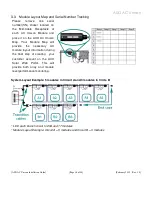
AUO AC Unison
[AUO AC Unison Installation Guide]
[Page 7 of 44]
[February 2012 Rev. 1.0]
Typical Wire Type:
Use THWN Wire Size of AWG #12 to #16. Data Logger is connected directly to the service panel to optimize Power Line
Communications. Optionally, the Data Logger can be connected to a NEMA 5-15 receptacle near the service panel.
Inverter output circuit:
A single branch circuit (maximum of 17 AC Unison modules per branch circuit) will terminate with a transition cable or an
extension cable that could be routed toward an electrical work box on the roof or another set of AC Unison modules on
another part of the roof. When the installer is routing AC cables out from under the array, the AC cables must be supported
and managed using best electrical practices and proper wire management equipment (e.g. wire tray, hangers, straps, etc.).
Direct to service entrance panel (as shown) or to a sub-panel off a higher rated breaker in the service entrance panel.
Supplied by installation company as part of Balance of System (BOS) components. Typical Wire Type depends on wiring
method to array. Size for 20 amp dedicated branch: minimum 12 AWG but may be larger due to temperature derating in
conduit or voltage drop due to distance. Transient voltage surge suppressor recommended for sites subject to lightning. See
NEC or CEC for AC wiring guidance, breaker placement, and panel loading.
Exterior-rated electrical distribution box with distribution block or terminal strip rated for 240 VAC 20A (supplied by
installation contractor).
Grounding lugs and external ground wires:
The AC cable provides equipment grounding for the AC Unison module only. It is the installer's responsibility to ensure that
any metallic parts in contact with the module (i.e. mounting systems) are provided with a means of equipment grounding
according to the manufacturer’s instructions and local code. Failure to provide proper grounding can void equipment warranty
in the case of lightning strike.
In areas subject to lightning, it is recommended to provide auxiliary grounding between the AC Unison module frame and the
racking to bond all metal together. This can be done with straps or fasteners approved for grounding PV module frames. The
entire array structure should then be connected directly to the ground electrode using a suitably sized copper conductor. (Note:
do not run this conductor in the conduit with the EGC or AC power conductors). Typical Wire Type: Green insulated wire size
must be no smaller than largest conductor in the PV system. If the ground wire is external, use a minimum 6 AWG per NEC or
CEC.
AC Unison module Interconnecting Cables: Exterior-rated AC cable with equipment grounding conductor (EGC) integrated
into the AC Unison module. Cables are rated for disconnect under load and can be used as an NEC disconnect device. Check
with the AHJ for requirements for a separate AC disconnect to be installed next to the PV array.
If the string will continue to another row, then an extension cable is needed. Plug the extension cable into the current module
and place it in the general position to connect to the next module you will install. For rail mount systems, lay the extension
cable over the rails on which the next module will be installed. This ensures that the cable remains under the module for
protection from the sun and uses the rails to keep the cable off the roof surface.
Summary of Contents for AC UNISON
Page 7: ...AUO AC Unison AUO AC Unison Installation Guide Page 6 of 44 February 2012 Rev 1 0 ...
Page 10: ...AUO AC Unison AUO AC Unison Installation Guide Page 9 of 44 February 2012 Rev 1 0 ...
Page 11: ...AUO AC Unison AUO AC Unison Installation Guide Page 10 of 44 February 2012 Rev 1 0 ...
Page 12: ...AUO AC Unison AUO AC Unison Installation Guide Page 11 of 44 February 2012 Rev 1 0 ...
Page 39: ...AUO AC Unison AUO AC Unison Installation Guide Page 38 of 44 February 2012 Rev 1 0 ...









































